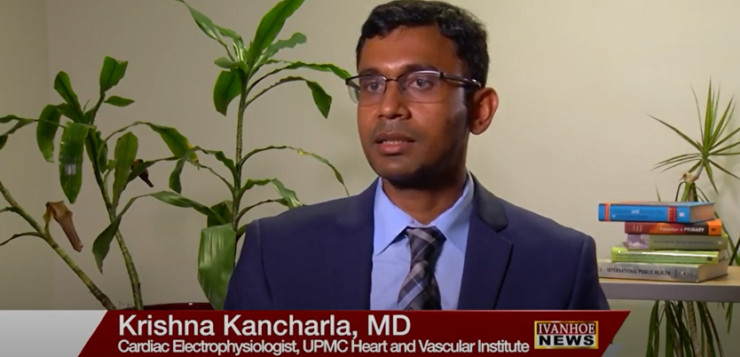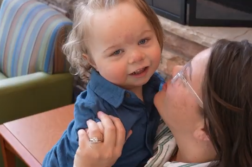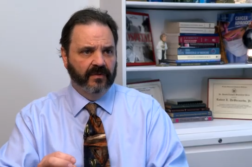Krishna Kancharla, MBBS, Cardiac Electrophysiologist, UPMC Heart and Vascular Institute, talks about a “non-invasive” experimental treatment that rids the heart of dangerous arrhythmia.
Can you tell me a little bit about ventricular tachycardia, VT … What is it going on in a person’s heart?
KANCHARLA: Yes. As the name suggests ventricular tachycardia is basically a description of the heart rate going fast, typically over 100 beats a minute but usually over 200 beats a minute starting from the ventricle which is the bottom chamber or the main pump of the heart. When the heart rate goes that fast , it’s not efficient and our circulation in the body is impaired leading to symptoms.
So, this is something that is symptomatic, a patient is going to feel this. What will it feel like to someone?
KANCHARLA: Yes. Most common symptom is feeling heart racing or thumping in the chest. We call these as palpitations. The other symptoms that can happen dizziness, fainting, chest pain or shortness of breath.
Is this fatal or can this lead to a fatal condition?
KANCHARLA: Yes. It is actually one of the reasons for sudden cardiac death. As you might know heart disease is one of the top five causes of death in the United States. And within those causes, heart rhythm problems, specifically ventricular tachycardia is one of the common reasons for sudden death.
Do we know commonly what causes it or what could cause it?
KANCHARLA: The most common reason for ventricular tachycardia is actually prior damage of the heart muscle. And one of the most common ways that the heart muscle can get damaged is by a heart attack or blockage of a blood vessel that supplies blood to the heart muscle. Patients who have had history of heart attack are at higher risk for having ventricular tachycardia, particularly so when the heart function is severely reduced because of the heart attack.
You had mentioned that it goes up to over sometimes 200 beats a minute. What is an average resting heart rate? What would people normally be having?
KANCHARLA: What we typically call a normal heart rate is anywhere between 50 and 100 beats a minute. More important than the heart rate, the normal heart rhythm starts from the actual upper chambers of the heart, called atria. Ventricular tachycardia comes from the bottom chambers of the heart or the ventricles. That’s the distinction.
What’s the traditional treatment for this?
KANCHARLA: Common treatments for the ventricular tachycardia are medications and if required an invasive procedure called catheter ablation. The medications are for heart failure therapy as well as to prevent the arrhythmias. For patients with ventricular tachycardia diagnosis, we use more specific anti-arrhythmic medications to treat these arrhythmias. These are usually administered orally once or twice a day. But really over 50% of the patients over time continue to have these arrhythmias despite these medications. Then we consider catheter ablation which is the invasive procedure I was referring to as an option. In this procedure we insert tubes into the veins and arteries and enter the heart to find the source of the problem and essentially cauterize a portion of the heart tissue to kill the muscle cells that are causing the arrhythmia. These are the two traditional options we use today.
Tell me a little bit about the experimental treatment that you and your colleagues are looking at.
KANCHARLA: In the last 10 years there has been interest in delivering radiation therapy directly to a focused areas of the heart, specifically the scarred areas that are causing the ventricular arrhythmias as treatment. In the last three to four years clinical data from Washington University, Phillip Cuculich and Cliff Robinson’s team showed that the ventricular tachycardia burden is significantly reduced in patients who have failed the common treatments, and then have received the radiation therapy directed to the specific areas of the heart.
Can you describe for our viewers how it is that you perform the procedure?
KANCHARLA: Yes. This is a completely non-invasive treatment. We select patients with recurrent ventricular tachycardia after they have tried the traditional therapy. Patients typically go through imaging studies for example, a CT scan and/or a cardiac MRI to find exactly where the area of scar is or where the heart attack has happened. And we also get information regarding the ventricular tachycardia by using a monitor or an EKG or their defibrillator-related electrical information. After putting this information together, we target a specific area of the heart that might be causing patient’s arrhythmia. This is all part of the treatment planning where my colleague Dr. Adam Olson and I will be sitting together and reviewing the CT scan, MRI and the electrical information to find the target treatment area. following this, patient will come on a separate day to receive the actual treatment which typically takes 20 to 30 minutes. The treatment is followed by several outpatient follow-up visits over the next years.
How do they receive the treatment doctor if it’s not invasive? I know you were talking about the ablation how you’re threading a catheter through and actually scarring, getting rid of that troublesome tissue. How is this different?
KANCHARLA: Yeah. So, majority of the planning and targeting actually happens before the patient comes into the procedure room because of the prior CT scan and the MRI that the patient has already received. So, all that work is done in the background. Once the patient comes in, we review and reconfirm the location that we want to target and then the linear accelerator precisely delivers the energy to that specific location of the heart in a three-dimensional fashion. So, from a patient standpoint, the patient would be lying down and following the breath instructions and the linear accelerator would be moving around the patient to deliver that specific amount of radiation to that tissue. The difference is in being noninvasive and potentially being able to target deeper tissue of the heart in a shorter time than catheter ablation.
How effective is this? How effective a solution is this for some patients?
KANCHARLA: The small literature we have from the Washington University and also from some other countries now, suggest significant reduction of the ventricular tachycardia burden, which means reduced number of episodes or the number of shocks that patients receive. Importantly, this reduction of burden was achieved after traditional therapies have failed. I know this is still investigational. What would it take for it to go from where it is now to an FDA approved treatment?
KANCHARLA: Yeah. Currently we’re really selecting patients on a case-by-case basis when everything has failed. But the future for this is to have a randomized clinical trial in which the patients will be going through standard of care versus radiation therapy arm to help us understand benefit and safety. This treatment has to go through a randomized controlled study to be reviewed by the FDA and be approved to be available as a routine therapy in the future.
How important is it doctor to have another option to offer patients?
KANCHARLA: Current state of ventricular tachycardia treatment is limited. At least up to 40% of the patients over five years after receiving traditional therapy have recurrence and be bothered by this problem again. This particularly happens in patients with weaker heart muscle which makes it much more difficult. The options we now have in those situations are heart transplant or a heart pump. So, more treatment options for ventricular tachycardia is a definite need and that is the basis for trying additional therapy like radiation therapy.
Is there anything I didn’t ask you that you want to make sure that people know?
KANCHARLA: The other important aspect to know about radiation therapy unlike the medications or catheter ablations, is that the side effects or potentially complications may happen over a longer term. So close follow up after the therapy is very important. We need to follow over several years to make sure no additional unintended complications are showing up in the future.
How many patients have you have you offered this treatment for do you think while you’ve been here?
KANCHARLA: We reviewed up to 10 patients and treated three patients so far.
And when did you start using this as a therapy?
KANCHARLA: Approximately a year ago.
And you said it’s been studied overseas in addition to Washington University?
KANCHARLA: Yes. Centers from Czech Republic has some data as well. Many centers globally are applying or using this off label therapy as needed however not have published their experience. I think there is a need to pursue a randomized trial with multiple centers together to really know the efficacy and safety of this approach. It still is experimental at this stage.
Interview conducted by Ivanhoe Broadcast News.
END OF INTERVIEW
This information is intended for additional research purposes only. It is not to be used as a prescription or advice from Ivanhoe Broadcast News, Inc. or any medical professional interviewed. Ivanhoe Broadcast News, Inc. assumes no responsibility for the depth or accuracy of physician statements. Procedures or medicines apply to different people and medical factors; always consult your physician on medical matters.
If you would like more information, please contact:
SHEILA DAVIS
Sign up for a free weekly e-mail on Medical Breakthroughs called First to Know by clicking here





